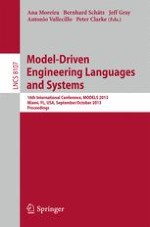2013 | Buch
Model-Driven Engineering Languages and Systems
16th International Conference, MODELS 2013, Miami, FL, USA, September 29 – October 4, 2013. Proceedings
herausgegeben von: Ana Moreira, Bernhard Schätz, Jeff Gray, Antonio Vallecillo, Peter Clarke
Verlag: Springer Berlin Heidelberg
Buchreihe : Lecture Notes in Computer Science
